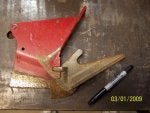Anybody have any practical advice for working with either of these Stoody hardfacing rods?
Stoody ATB
Stoody Bare Borod
I've got a job coming up to hardface some agricutural parts and I'm considering using one of these instead of, or along with, an arc welding rod(McKay hardalloy 140). There are 2 sets of components I'm working on. Some sharp-edged steel teeth, and some plates that surround some kind of planting device. I need to hardface the cutting edge of the teeth, and the bottom 1/2" of each plate. Will post pics as soon as the parts arrive.
The reason I'm thinking these may work better is:
I think a O-A rod that is sweated to the surface will leave a thinner deposit and not distort the cutting edge of the teeth. I'm trying to avoid having to reshape, grind, or otherwise sharpen these teeth when I'm done. I'm concerned that if I run beads of the hardalloy 140 on either side of the cutting edge, the resulting surface will be too blunt.
The hardalloy 140 will go down faster on the plates, resulting in less distortion and less time.
There's only 10 of each, so I'm not considering MIG/Fluxcore hardfacing. Too much leftover product when I'm done.
Stoody ATB
Stoody Bare Borod
I've got a job coming up to hardface some agricutural parts and I'm considering using one of these instead of, or along with, an arc welding rod(McKay hardalloy 140). There are 2 sets of components I'm working on. Some sharp-edged steel teeth, and some plates that surround some kind of planting device. I need to hardface the cutting edge of the teeth, and the bottom 1/2" of each plate. Will post pics as soon as the parts arrive.
The reason I'm thinking these may work better is:
I think a O-A rod that is sweated to the surface will leave a thinner deposit and not distort the cutting edge of the teeth. I'm trying to avoid having to reshape, grind, or otherwise sharpen these teeth when I'm done. I'm concerned that if I run beads of the hardalloy 140 on either side of the cutting edge, the resulting surface will be too blunt.
The hardalloy 140 will go down faster on the plates, resulting in less distortion and less time.
There's only 10 of each, so I'm not considering MIG/Fluxcore hardfacing. Too much leftover product when I'm done.










